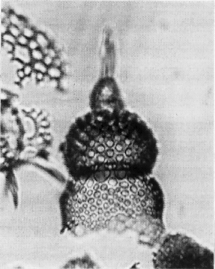 Calocycletta
(Calocycletta) cladara Sanfilippo and Riedel
Calocycletta
(Calocycletta) cladara Sanfilippo and Riedel Calocycletta
(Calocycletta) cladara Sanfilippo and Riedel
Calocycletta
(Calocycletta) cladara Sanfilippo and RiedelCalocycletta (Calocycletta) cladara Sanfilippo and Riedel, 1992, p.30, l.2, figs.12-16
Three-segmented pterocorythid with the cephalis distinctly pored, bearing a rather strong, slightly bladed horn. Generally, the lateral lobes of the cephalis are indistinct, and do not cause a distinct break in its contour. Thorax inflated-conical to subspherical, with pores irregular in size and arrangement, which in late forms tend to be larger near the collar stricture and with their bars joining the cephalis above the level of the collar pores. The thoracic wall is a thin, porous lamella proximally, becoming much thicker distally where the pore frames are high. Abdomen distinctly more delicate than the thorax, irregularly subcylindrical, often constricted medially; when observed complete, which is rarely, terminated with a thin poreless peristome bearing small teeth. In late forms the row of pores just below the lumbar stricture increase in size to two or three times the size of the surrounding pores (Sanfilippo and Riedel, 1992).
Based on 50 specimens. Length (excluding horn) 110-215 µm (usually about 156 µm), length of cephalothorax 75-110 µm; width of thorax 80-105 µm, width of abdomen 85-135 µm (usually about 110 µm) (Sanfilippo and Riedel, 1992).
This species differs most markedly from others of the genus by the lack of regular pore arrangement. It bears a superficial resemblance to some species of Albastrossidium and Lamprocyclas, but tracing its evolution revealed its true relationship to Calocycletta virginis. In the latest members of the latter species the thoracic pores lose their strict regular arrangement the horn tends to become bladed and some specimens have a delicate abdomen lacking teeth. It differs from Pterocorys minythorax (Nigrini) (Caulet and Nigrini, 1988, p.231, pl.2, fig.6) by its larger thorax (P. minythorax thoracic width 63-72 µm; length of cephalothorax 63-81 µm), its irregular pore arrangement and the tendency in later forms to develop larger pores at the collar and lumbar strictures. The theoperid Stichocorys johnsoni Caulet is confusingly similar. It also displays the larger pores just below the lumbar stricture and the same sinuous abdomen, but it has a simple cephalis (Sanfilippo and Riedel, 1992).
The transition from C. virginis to C. cladara occurs near the boundary between the Dorcadospyris alata Zone and the Diartus petterssoni Zone (middle Miocene), and C. cladara becomes extinct in the lower part of the Stichocorys peregrina Zone (near the Miocene/Pliocene boundary). C. cladara occurs in low abundances in all of the Miocene assemblages of the appropriate age from latitudes lower than 40°. It reaches its highest abundances (up to 5% of the total assemblage) in the late Miocene Indian Ocean assemblages (Sanfilippo and Riedel, 1992).
C. cladara arose from C. virginis and left no descendants. It terminates the subgenus Calocycletta (Calocycletta).